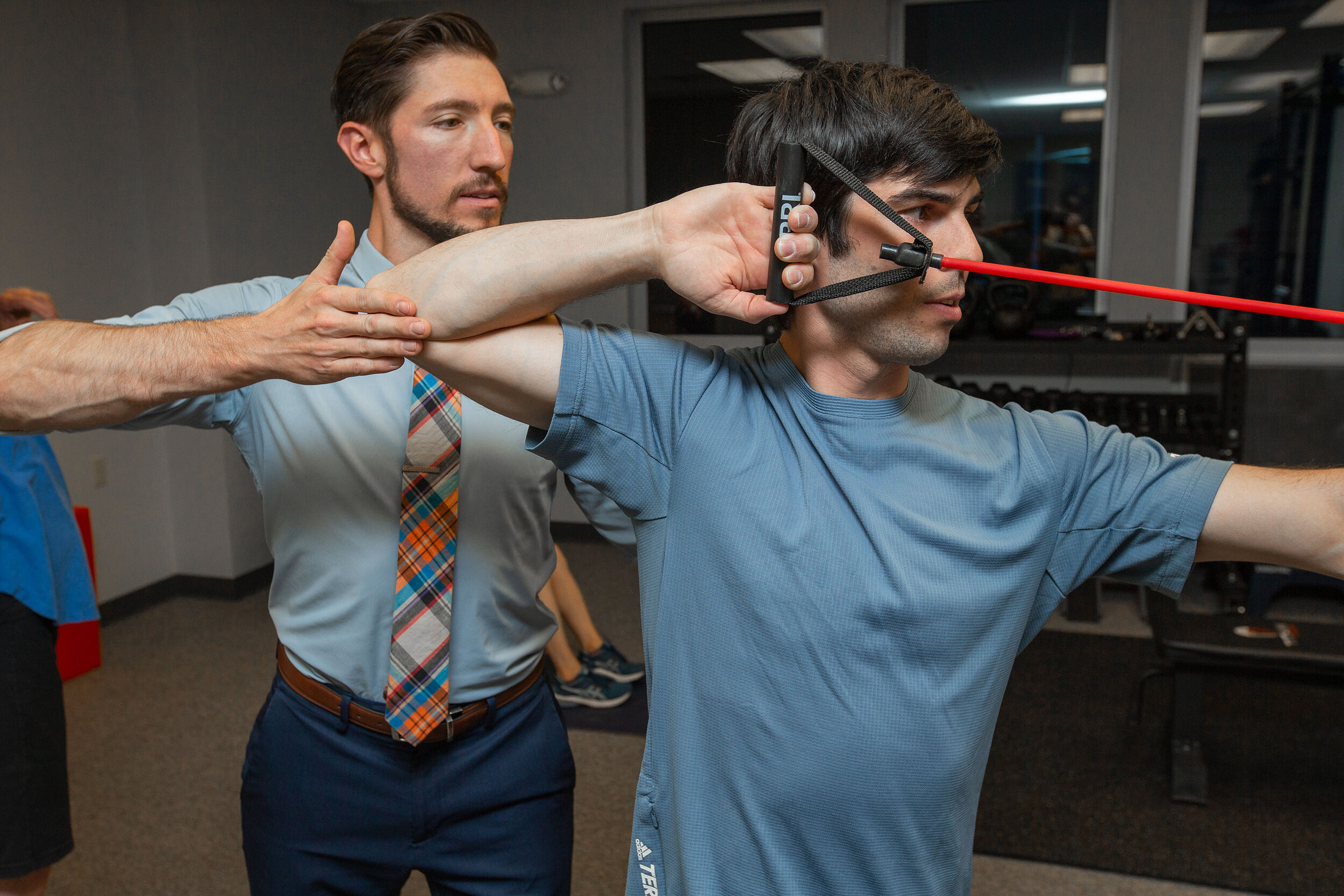Shoulder injuries account for approximately 17% of all climbing-related injuries, making them one of the most common reasons why people seek rock climbing therapy. The shoulder is a complex joint that takes a significant load while climbing, especially as difficulty increases. If you sustain a shoulder injury from climbing, it’s crucial to get the right diagnosis and then follow a treatment plan that is designed specifically for rock climbing movements.
Because of the repetitive nature of climbing, certain patterns of impairments begin to emerge. Many climbers present with muscular tightness to the latissimus dorsi and pectoral muscles, stiffness to the shoulder joints, weakness of the scapular stabilizers and rotator cuff, or stiffness to the thoracic spine joints. All these impairments can be contributing factors to shoulder pain. There are dozens of issues that can cause pain, but the most common rock climbing shoulder injuries are subacromial pain syndrome (also called shoulder impingement), rotator cuff pain, and biceps tendinopathy.
1. Subacromial Pain Syndrome
Subacromial pain syndrome (aka shoulder impingement) occurs when the structures of the shoulder in the subacromial space get aggravated during movements of the arm. Climbers with this condition commonly experience pain while reaching across their body, doing gaston movements, or reaching/pulling with the arm stretched to the side or overhead. Symptoms often get worse as your elbows raise up when you’re near your limit of fatigue while climbing.
There is an extensive body of literature supporting the use of physical therapy for the treatment of subacromial pain syndrome (1). The best treatment plans use a combination of manual therapy and exercises. Manual therapy may focus on thoracic manipulation/adjustments (2), mobilizations to the glenohumeral joint (3), and treatments directed at muscles such as dry needling or soft tissue mobilization. Manual therapy has been shown to speed up the rehab process and treat the rock climbing shoulder pain faster than exercises alone. (4)
Exercise therapy may focus on exercises to improve rotator cuff strength, scapular stability, as well as shoulder and thoracic spine mobility. (5) A good exercise program should be challenging enough to build adequate tissue capacity to handle the high loads of rock climbing.
2. Rotator Cuff Pain
Rotator cuff pain can be due to pathology within the rotator cuff muscles or tendons and can be caused by repetitive stress or trauma to the shoulder. This condition is often painful during repetitive pulling during gaston movements, with the arm overhead, or out to the side. Symptoms are often worse when climbing on overhangs or during high-intensity bouldering movements.
There is great data to support the use of manual therapy and exercises in the treatment of rotator cuff pain. (6) Manual therapy for this kind of rock climbing shoulder pain should focus on treatments targeting muscular trigger points or the rotator cuff tendon such as dry needling. (7)
The most effective treatment for rotator cuff pain is a progressive strengthening program for the rotator cuff. This program needs to effectively match the current tissue capacity of the muscle and be progressive over time as the tissue heals. Once again, the best treatment program uses a combination of manual and exercise therapy and should cater to climbing-specific movements.
3. Biceps Tendinopathy
Biceps tendinopathy is an overuse pattern or a chronic degeneration of the long head of the biceps tendon. You may feel pain from biceps tendinopathy during repetitive pulling up or locking off movements or when reaching the arm over the head. The pain is often aggravated by climbing with poor shoulder mechanics. This condition sometimes feels better while climbing or being active but then becomes more painful once the activity is over.
The long head of the biceps tendon is often irritated by compression as it passes in front of the humerus in the shoulder. In many cases, the biceps tendon gets irritated because it has to act as a primary stabilizer for the shoulder when the rotator cuff is weak. Stiffness in the shoulder joint and weakness of the rotator cuff can cause forward translation of the humerus, leading to chronic irritation of the biceps tendon.
Research strongly supports the use of manual and exercise therapy for rehabilitation of this injury. Manual therapy for these rock climbing shoulder injuries may involve joint mobilizations and dry needling.(8) Exercises may consist of rotator cuff strengthening to better position the humerus and a progressive strengthening program to the biceps to cause positive changes to the structure of the tendon.
We have lots of free resources available including videos and blog posts to help you better understand your shoulder pain. To get an accurate diagnosis and develop an effective treatment plan, schedule a free consultation with one of the climbing experts at Mend.
Sources- 1. Pieters, 2020. 2. Boyles, 2009. 3. Tate, 2010. 4. Bergman, 2004. 5. Kuhn, 2009. 6. Desjardins-Charbonneau, 2015. 7. Saylor-Pavkovich, 2016. 8. McDevitt, 2018

